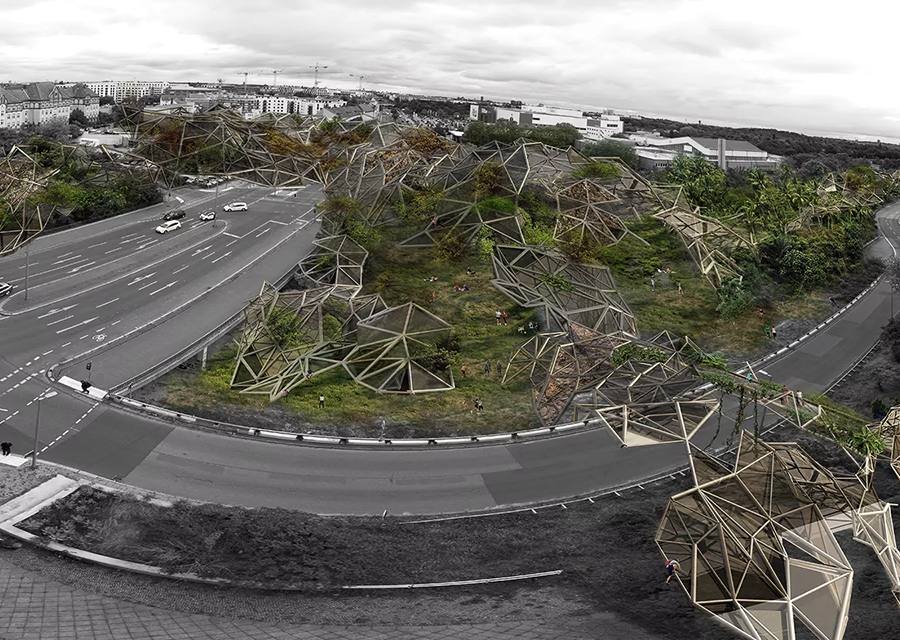The Berlin-Atlas exhibition of the BDA Gallery Berlin (Gallery of the Association of German Architects) features Hybrid Space Lab’s ReWild Autobahn project.
Exhibition ReWild Autobahn @ BDA Gallery, Mommsenstrasse 64, Berlin, 6 October-26 November 2021
ReWild Autobahn proposes a hybrid – natural and artificial – landscape on a dismantled urban freeway as a green corridor for non-humans and humans.
Over the last century, the mobility infrastructure that has developed in the southern part of the Berlin Schöneberg district, crossing and slicing the urban fabric, has given rise to small, disconnected urban islands.
Today, the routes of the mobility infrastructure separate the city islands. Following the 2019 decision by the Berlin Tempelhof- Schöneberg district, the dismantling of the Autobahn 103 and the corresponding adaptation of the Sachsendamm junction will enable the connection of the city islands and allow animals and people to migrate.
The project ReWild Autobahn aims at creating a lush, hybrid natural and artificial green connection, bridging these islands and closing the gap.
A complex three-dimensional spatial flow is created through which various animals cross, where plants find habitats and people can relax, play and exercise.
The project bridges an existing gap, proposing a long, green corridor for people and animals going through the Insulaner to the Red Island with the Cherusker Park and then towards the city center.
In ReWild Autobahn, the green space at the Dominicus sports field grows towards the northwest with the help of a hybrid (natural and artificial) landscape and is connected to the axis of the New Twelve Apostles Churchyard with a pedestrian bridge. This hybrid landscape leads below (as a green underpass) and above the Sachsendamm to the green spaces of the Inselhunde Schöneberg and the Volkshochschule Schöneberger Linse and then to the sports facilities and playgrounds at Cheruskerpark.
Infrastructure relics of the car-friendly city from the last century are used as a reservoir of space for a Green Infrastructure, which is becoming increasingly urgent today in times of climate change and biodiversity loss.
With an Animal-Aided Design (AAD) approach that integrates the needs of urban-dwelling animals into urban development, ReWild Autobahn develops urban spaces as habitats for people and animals, foregrounding the interrelationships of species – in the spirit of a Multispecies Urbanism.
As part of Hybrid Space Lab’s Green Artificial Intelligence Architecture (G AI A) project series, ReWild Autobahn investigates how to make meaningful connections between AI, architecture, and nature, cutting through the noise and hypes of Smart City narratives, and finding creative responses to the climate and biodiversity crisis.
Architecture does not work in a vacuum – when it works with, on, and along what is presently there, it casts a critique and lays out proposals for its amelioration. Architecture transforms, overcomes, integrates, reshapes, complements, lightens, contrasts, alienates, dares to reinterpret, overhypes, mistreats, sophisticates, condenses, and liberates. And by affirmative criticism, it shows possibilities.
Berlin
Atlas
Exhibition
During the vernissage the exhibited contributions will be presented and commented by:
Antje Buchholz, BARarchitekten Berlin
Prof. Karen Eisenloffel, Brandenburg University of Technology
Manfred Kühne, Head of Department of Urban Development and Projects, Berlin Senate Department for Urban Development and Housing
Urs Füssler, Architect, Association of German Architects
Andrew Albers, Architectural Photographer, Berlin
Multispecies
Urbanism
related PROJECTS
